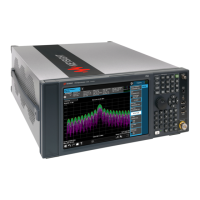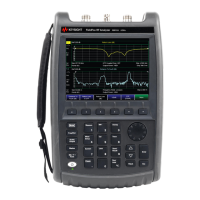N9030B PXA Signal Analyzer Service Guide 189
RF Section Troubleshooting (Millimeter-Wave Analyzers)
Troubleshooting
Quick Check to Verify High Band RF Path
Refer to the RF Highband Path #1 Block Diagram (Options 544, and 550) in
Chapter 13.
The High Band signal path (sometimes referred to as Band 1-Band 6) is used
for all signals 3.6 GHz and above. If the start frequency is set to 3.6 GHz and
above, the analyzer displays only the High Band signal path. If the analyzer
start frequency is below 3.6 GHz and the Stop frequency is set above 3.6 GHz,
the analyzer will start sweeping in Low Band up to 3.6 GHz, and then
automatically switch to the high band path above 3.6 GHz.
Equipment needed:
Spectrum Analyzer with frequency range to 14 GHz
Signal source with output power 0 dBm and frequency range to at least the
maximum frequency of the PXA
Power splitter, 11667C
2 each, quality 2.4 mm cables
90° SMA (m) to SMA (f) adapter
MMCX (f) to SMA (f) cable
SMA (f) to SMA (f) adapter
SMA (m) to SMA (m) adapter
3.5mm (f) to 2.4 mm (m) adapters (2 required)
3.5 mm (m) to 2.4 mm (f) adapter
Turn the instrument on and allow it to complete its full boot up process to
Signal Analyzer mode. Use the internal 4.8 GHz, −28 dBm calibrator signal as a
reference for troubleshooting by pressing Mode Preset, Input/Output, RF
Calibrator, 4.8 GHz on the analyzer. Now press FREQ (Channel), 4.8 GHz,
SPAN (X Scale), 1 MHz, Peak Search).
The 4.8 GHz reference signal should measure −28 dBm ± 2 dB on the analyzer
display. If the power level is within tolerance, the 3.6 GHz to 17.1 Ghz path is
functioning correctly at 4.8 Ghz.
If the power level is incorrect, select the 50 MHz RF calibrator and set the
analyzer center frequency to 50 MHz. Since several of the same signal path
components are shared between high band and low band, determining if the
problem appears in both paths is helpful.
To perform the following checks, it will be necessary to remove the outer
cover and the top brace. See Chapter 16 for removal procedures.

